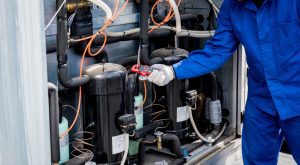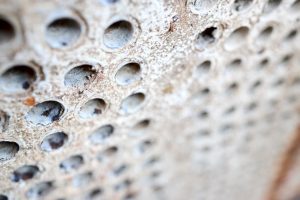Engineer inspects spiral heat exchanger in petroleum industrial plant.
Heat exchangers play an essential role in industrial operations, facilitating the efficient transfer of thermal energy across various sectors. From oil refineries to chemical processing plants, power generation facilities to HVAC systems, these critical components enable sustainable and energy efficient processes. However, their continuous exposure to extreme conditions including high temperatures, corrosive substances, and high-pressure fluids makes them susceptible to various forms of degradation.
By Omari Hussein Sabuni, Mechanical Engineer, Kinyerezi Power Plant
The necessity for rigorous inspection protocols cannot be overstated. As heat exchangers operate in increasingly demanding environments, the risk of performance degradation, efficiency losses, and potential failures grows significantly. This article delves into the crucial aspects of heat exchanger inspection, offering insights into inspection frequencies, scheduling strategies, essential tools, and both in-service and shutdown inspection procedures. By understanding and implementing these practices, organizations can significantly enhance their maintenance strategies, optimize operational efficiency, and prevent costly failures.
Understanding inspection frequency requirements
Routine inspection protocols
The foundation of effective heat exchanger maintenance lies in daily and weekly monitoring procedures. Operating personnel must conduct regular temperature differential monitoring across the exchanger using calibrated instruments, as unexpected variations often serve as early indicators of developing problems such as fouling or reduced heat transfer efficiency. Alongside temperature monitoring, pressure differential analysis forms a critical component of routine inspections. By establishing baseline measurements and tracking deviations, operators can quickly identify potential blockages or flow restrictions that might impact system performance.
The verification of consistent fluid flow rates is equally important, as maintaining designed flow parameters ensures optimal heat transfer efficiency throughout the system. External visual inspections constitute another vital aspect of routine monitoring. Qualified personnel should thoroughly examine the equipment’s exterior for any signs of leakage, which might manifest as drips, stains, or dampness around joints and connections. They must also pay close attention to vibration patterns and noise levels, as changes in these parameters often indicate developing mechanical issues. Surface corrosion indicators require careful observation, particularly around joints, supports, and areas exposed to harsh environmental conditions. The integrity of insulation materials must also be verified to maintain system efficiency and prevent energy losses.

Periodic inspection requirements
Semi-annual to annual inspections demand a more comprehensive evaluation approach that begins with sophisticated non-destructive testing methods. Ultrasonic thickness measurements provide crucial data about wall thinning patterns, helping maintenance teams predict potential failure points before they develop into critical issues. Eddy current testing proves invaluable for assessing tube integrity, capable of detecting both surface and subsurface defects that might compromise system performance. Magnetic particle inspection techniques enable detailed examination of surface conditions, particularly effective for identifying developing cracks in ferromagnetic materials. Penetrant testing complements these methods by providing detailed information about weld integrity and surface discontinuities.
The development and implementation of cleaning schedules form another critical component of periodic inspections. Maintenance teams must assess fouling levels through various methods, including pressure drop analysis and heat transfer efficiency calculations. Based on these assessments, they can implement appropriate chemical cleaning protocols, selecting specific cleaning agents based on the type of fouling present and the material composition of the heat exchanger. In cases where chemical cleaning proves insufficient, mechanical cleaning methods may be necessary, though these must be conducted with great care to prevent damage to heat exchanger surfaces.
Mechanical integrity verification represents the third major aspect of periodic inspections. This includes detailed assessment of gasket conditions, looking for signs of deterioration, compression set, or chemical attack that might compromise sealing integrity. Bolt torque requires careful checking and adjustment to maintain proper sealing force while preventing over-compression that could damage gaskets or flanges. Flange faces must be examined for signs of corrosion, erosion, or mechanical damage that could affect sealing capability. Support structures require thorough evaluation to ensure they continue to provide adequate support while allowing for thermal expansion and contraction.
Comprehensive inspection planning
The most thorough examinations, typically conducted every three to five years, begin with a complete system disassembly process. This involves the careful removal of tube bundles, requiring specialized equipment and trained personnel to prevent damage during extraction. Internal components must be made accessible through systematic disassembly, with each step carefully documented to ensure proper reassembly later. The documentation process should include photographs, measurements, and detailed notes about the condition of each component as it is removed.
Component assessment during these comprehensive inspections must be extremely detailed. Microscopic examination of tube surfaces reveals subtle signs of deterioration that might be missed during less thorough inspections. Shell-side inspection requires careful attention to erosion and corrosion patterns, particularly in areas of high flow velocity or where phase changes occur. Baffle condition evaluation focuses on signs of wear, displacement, or damage that could affect flow patterns and heat transfer efficiency. Header box examination must cover all internal surfaces, looking for signs of corrosion, erosion, or cracking that could lead to mixing of process fluids.
Advanced testing procedures form the final phase of comprehensive inspections. Hydrostatic testing, when applicable, provides crucial information about system integrity under pressure. Tube bundle pressure testing helps identify any leaks or weak points that could lead to crosscontamination between fluids. Shell-side integrity verification ensures the pressure boundary remains sound and capable of containing process fluids safely. Comprehensive non-destructive testing implementation brings together multiple inspection technologies to provide a complete picture of equipment condition.
Strategic inspection scheduling
 Daily operational monitoring
Daily operational monitoring
The implementation of effective daily monitoring systems requires a sophisticated approach to performance tracking. Modern facilities employ automated monitoring systems that continuously collect data on critical parameters such as temperature, pressure, and flow rates. This data undergoes regular analysis to identify trends that might indicate developing problems. The system should be capable of generating early warning signals when parameters deviate from established norms, allowing operators to take corrective action before minor issues develop into major problems.
Visual inspection protocols require careful development and implementation. Facilities must establish standardized inspection routes that ensure all critical components receive appropriate attention. These routes should be documented in detailed inspection checklists that guide operators through the inspection process, ensuring consistency and completeness. The reporting procedures must provide clear guidelines for documenting observations and escalating concerns when necessary.
Proper training ensures inspection personnel understand both what to look for and how to interpret their observations effectively.
Monthly and quarterly assessments
Thermal analysis during monthly and quarterly assessments provides crucial information about system performance and condition. Infrared scanning programs help identify hot spots or unusual temperature patterns that might indicate developing problems. Regular documentation of temperature patterns enables comparison over time, helping identify gradual changes that might otherwise go unnoticed. Hot spot identification requires careful analysis to determine whether elevated temperatures indicate normal operating conditions or developing problems. Thermal efficiency assessment helps track system performance over time, identifying gradual degradation that requires attention.
The mechanical evaluation process requires a systematic approach to equipment examination. Detailed external inspection procedures guide technicians through a thorough examination
of all accessible components. Vibration analysis implementation helps identify developing mechanical problems before they become severe enough to cause failure. Noise level monitoring provides additional information about equipment condition, as changes in operating sounds often indicate developing problems. Support system evaluation ensures the equipment remains properly supported while accommodating thermal movement and maintaining alignment.
Essential inspection tools and technologies
Advanced non-destructive testing equipment
Modern ultrasonic testing systems provide sophisticated capabilities for assessing equipment condition. These systems combine accurate thickness measurement capabilities with advanced flaw detection functionality, enabling inspectors to identify both general wall thinning and localized defects. Data recording and analysis features allow trending of results over time, helping predict future deterioration rates. Proper calibration procedures ensure measurement accuracy and repeatability, crucial for making sound maintenance decisions. Eddy current testing equipment has evolved to provide highly sensitive detection capabilities for various types of defects. Modern systems offer sophisticated signal analysis functions that help inspectors differentiate between different types of indications. Data recording systems enable documentation of findings for future reference and comparison. Probe selection criteria must consider factors such as tube material, expected defect types, and inspection speed requirements to ensure effective examinations.
Digital monitoring systems
Contemporary sensor systems provide continuous monitoring of critical parameters. Temperature monitoring equipment must offer both accuracy and reliability for extended operation. Pressure measurement systems need to combine accuracy with durability in demanding industrial environments. Flow rate tracking requires sophisticated instruments capable of handling various fluid types and operating conditions. Vibration analysis equipment must provide detailed information about equipment condition while remaining reliable in harsh industrial environments. Data management tools have become increasingly sophisticated and crucial for effective inspection programs. Modern collection systems can handle large volumes of data from multiple sources simultaneously. Analysis software helps identify trends and patterns that might indicate developing problems. Trending capabilities enable prediction of future conditions based on historical data. Reporting functions generate clear, detailed documentation of findings and recommendations for maintenance planning.
Conclusion
The implementation of a comprehensive heat exchanger inspection program represents a critical investment in operational reliability and safety. Through careful attention to inspection frequency, strategic scheduling, and the utilization of appropriate tools and technologies, organizations can significantly enhance their maintenance effectiveness and equipment longevity.
Success in heat exchanger maintenance requires a commitment to continuous improvement and adaptation to emerging technologies and methodologies. Organizations must regularly review and update their inspection protocols to incorporate new techniques and address evolving operational challenges. This includes evaluating current inspection protocols against industry best practices, assessing tool and technology requirements for comprehensive inspections, developing structured implementation plans for enhanced procedures, investing in staff training to ensure proper execution, and establishing regular review periods to evaluate and improve inspection programs.
 About the author
About the author
Omari Hussein Sabuni is an experienced mechanical engineer at Kinyerezi Gas Power Plant, specializing in heat exchanger design, optimization, troubleshooting and providing practical solutions for various heat exchanger problems. He is skilled in analyzing thermal systems and developing innovative solutions to enhance heat transfer efficiency and adept at conducting feasibility studies, performing risk assessments, and ensuring compliance with industry standards.
About this Featured Story
Why Subscribe?
Featured Stories are regularly shared with our Heat Exchanger World community. Join us and share your own Featured Story on Heat Exchanger World online and in print.



 About the author
About the author